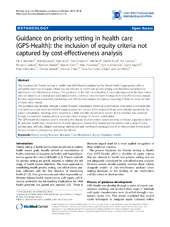Guidance on priority setting in health care (GPS-Health): the inclusion of equity criteria not captured by cost-effectiveness analysis
| dc.contributor.author | Norheim, Ole Frithjof | en_US |
| dc.contributor.author | Baltussen, Rob | en_US |
| dc.contributor.author | Johri, Mira | en_US |
| dc.contributor.author | Chisholm, Dan | en_US |
| dc.contributor.author | Nord, Erik | en_US |
| dc.contributor.author | Brock, Dan W. | en_US |
| dc.contributor.author | Carlsson, Per | en_US |
| dc.contributor.author | Cookson, Richard | en_US |
| dc.contributor.author | Daniels, Norman | en_US |
| dc.contributor.author | Danis, Marion | en_US |
| dc.contributor.author | Fleurbaey, Marc | en_US |
| dc.contributor.author | Johansson, Kjell Arne | en_US |
| dc.contributor.author | Kapiriri, Lydia | en_US |
| dc.contributor.author | Littlejohns, Peter | en_US |
| dc.contributor.author | Mbeeli, Thomas | en_US |
| dc.contributor.author | Rao, Krishna D. | en_US |
| dc.contributor.author | Edejer, Tessa Tan-Torres | en_US |
| dc.contributor.author | Wikler, Dan | en_US |
| dc.date.accessioned | 2014-09-29T11:48:34Z | |
| dc.date.available | 2014-09-29T11:48:34Z | |
| dc.date.issued | 2014-08-29 | eng |
| dc.identifier.issn | 1478-7547 | |
| dc.identifier.uri | https://hdl.handle.net/1956/8574 | |
| dc.description.abstract | This Guidance for Priority Setting in Health Care (GPS-Health), initiated by the World Health Organization, offers a comprehensive map of equity criteria that are relevant to health care priority setting and should be considered in addition to cost-effectiveness analysis. The guidance, in the form of a checklist, is especially targeted at decision makers who set priorities at national and sub-national levels, and those who interpret findings from cost-effectiveness analysis. It is also targeted at researchers conducting cost-effectiveness analysis to improve reporting of their results in the light of these other criteria. The guidance was develop through a series of expert consultation meetings and involved three steps: i) methods and normative concepts were identified through a systematic review; ii) the review findings were critically assessed in the expert consultation meetings which resulted in a draft checklist of normative criteria; iii) the checklist was validated though an extensive hearing process with input from a range of relevant stakeholders. The GPS-Health incorporates criteria related to the disease an intervention targets (severity of disease, capacity to benefit, and past health loss); characteristics of social groups an intervention targets (socioeconomic status, area of living, gender; race, ethnicity, religion and sexual orientation); and non-health consequences of an intervention (financial protection, economic productivity, and care for others). | en_US |
| dc.language.iso | eng | eng |
| dc.publisher | BioMed Central | eng |
| dc.rights | Attribution CC BY | eng |
| dc.rights.uri | http://creativecommons.org/licenses/by/4.0 | eng |
| dc.subject | Priority setting | eng |
| dc.subject | Resource allocation | eng |
| dc.subject | Cost-effectiveness | eng |
| dc.subject | Equity | eng |
| dc.subject | Population health | eng |
| dc.title | Guidance on priority setting in health care (GPS-Health): the inclusion of equity criteria not captured by cost-effectiveness analysis | en_US |
| dc.type | Peer reviewed | |
| dc.type | Journal article | |
| dc.date.updated | 2014-09-22T23:03:49Z | |
| dc.description.version | publishedVersion | en_US |
| dc.rights.holder | Copyright 2014 Norheim et al.; licensee BioMed Central Ltd. | |
| dc.rights.holder | Ole F Norheim et al.; licensee BioMed Central Ltd. | |
| dc.source.articlenumber | 18 | |
| dc.identifier.doi | https://doi.org/10.1186/1478-7547-12-18 | |
| dc.identifier.cristin | 1175720 | |
| dc.source.journal | Cost Effectiveness and Resource Allocation | |
| dc.source.40 | 12 |

